|
|
|
Sort Order |
|
|
|
Items / Page
|
|
|
|
|
|
|
| Srl | Item |
| 1 |
ID:
158218
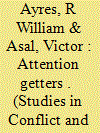

|
|
|
|
|
| Summary/Abstract |
Why do some ethno-political organizations get support from their diaspora while others do not? There is little analysis that examines why some organizations (both violent and nonviolent) get support. Using data on 112 organizations in the Middle East we examine how factors like the power of the organization, ideology, political behavior, and government treatment might impact the likelihood of an organization getting support from its diaspora. We argue that contentious political behavior should have the largest impact on such support. We find that those that do the best job of getting attention through visible action get the most support.
|
|
|
|
|
|
|
|
|
|
|
|
|
|
|
|
| 2 |
ID:
113530
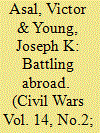

|
|
|
|
|
| Publication |
2012.
|
| Summary/Abstract |
Why are some terrorist organizations more likely to be targets of transnational counterterrorist operations? Previous work has identified characteristics of the environment or country involved to explain variation in targeting. We focus on characteristics of the violent organization to explain this variation. Using cross-national data on terrorist organizations and state targeting of these organizations, we identify several factors that help explain the variation in why some organizations are likely to be targeted while others are not.
|
|
|
|
|
|
|
|
|
|
|
|
|
|
|
|
| 3 |
ID:
190835


|
|
|
|
|
| Summary/Abstract |
Much ado has been made about the specter of unconventional weapons in the hands of militant groups. Despite the alarmism of the policy community, the pursuit of chemical, biological, radiological, and nuclear capabilities by non-state actors is rare. What explains why some violent non-state organizations pursue chemical, biological, radiological, and nuclear weapons while most do not? Using new data on organizational behaviors and attributes from the Big Allied and Dangerous 2 Insurgency project, we analyze 140 insurgent actors, from 1998 to 2012. We expand previous work by Asal, Ackerman & Rethemeyer by studying the phenomenon longitudinally and attending to organizational behavior rather than only to structural and environmental factors. We find that organizations that attack cultural sites are more likely to pursue and use chemical, biological, radiological, and nuclear weapons. We interpret the latter as a willingness to transgress upon accepted mores, for the sake of sensationalism and shock value, which coheres with a willingness to pursue unconventional weapons. Our results reflect that chemical, biological, radiological, and nuclear pursuit and use is part of a larger strategy for some violent non-state organizations, one predicated on generating mass fear and exacting a psychological toll.
|
|
|
|
|
|
|
|
|
|
|
|
|
|
|
|
| 4 |
ID:
167381
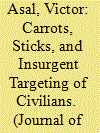

|
|
|
|
|
| Summary/Abstract |
How do conciliatory and coercive counterinsurgency tactics affect militant group violence against civilians? Scholars of civil war increasingly seek to understand intentional civilian targeting, often referred to as terrorism. Extant research emphasizes group weakness, or general state attributes such as regime type. We focus on terrorism as violent communication and as a response to government actions. State tactics toward groups, carrots and sticks, should be important for explaining insurgent terror. We test the argument using new data on terrorism by insurgent groups, with many time-varying variables, covering 1998 through 2012. Results suggest government coercion against a group is associated with subsequent terrorism by that group. However, this is only the case for larger insurgent groups, which raises questions about the notion of terrorism as a weapon of the weak. Carrots are often negatively related to group terrorism. Other factors associated with insurgent terrorism include holding territory, ethnic motivation, and social service provision.
|
|
|
|
|
|
|
|
|
|
|
|
|
|
|
|
| 5 |
ID:
134574
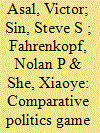

|
|
|
|
|
| Summary/Abstract |
Undergraduates often struggle with theoretical perspectives in political science. Often students can get a better handle on theories if they are able to relate them to something tangible in their experience. Lichbach and Zuckerman lay out cultural, rational actor, and structural perspectives as a way to think more systematically about comparative politics but often students struggle with these meta-theories and the different ways they encourage us to think theoretically about comparative politics. In this paper, we discuss a set of exercises that enable students to get a better handle on cultural, rational actor, and structural perspectives on comparative politics by making them “lab rats in their own experiments.” We group these exercises together and treat them as a Comparative Politics Game Show. In this paper, we describe the different exercises and how they were used and our view of the utility of this approach for teaching comparative politics theory.
|
|
|
|
|
|
|
|
|
|
|
|
|
|
|
|
| 6 |
ID:
084086


|
|
|
|
|
| Publication |
2008.
|
| Summary/Abstract |
This study examines the factors that lead household members to give or refuse consent for other household members to become a militant (or mujahid). Using data derived from a detailed survey fielded among a convenience sample of 141 families of slain militants in Pakistan, this manuscript seeks to explain why some families support participation in jihad and why some families do not. Using the extant literature on recruitment, participation in violent political conflict, and militant Islam as a guide, we posit how and why various household attributes should affect a household member to grant or refuse permission for another household member to wage jihad. We then test our hypotheses implied by our argument using data on households' financial, religious, and social characteristics. We conclude that a number of social, economic, and religious factors account for variation in household members' support of jihad.
|
|
|
|
|
|
|
|
|
|
|
|
|
|
|
|
| 7 |
ID:
178768
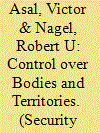

|
|
|
|
|
| Summary/Abstract |
Despite the popular narrative of “rape as a weapon of war,” research shows that only a minority of insurgent groups perpetrate sexual violence in armed conflict. We argue that territorial control is an overlooked factor that can increase the likelihood a group commits sexual violence for two primary reasons: (1) rebel groups seeking to establish control over territory are more likely to commit sexual violence; and (2) groups seeking to maintain territorial control emulate state behavior through violently controlling human, sexual, and reproductive capital, which manifests in forced recruitment and different forms of sexual violence, including rape and sexual slavery. We systematically test this argument using the Sexual Violence in Armed Conflict (SVAC) and the Big Allied and Dangerous Insurgent II (BAADI2) datasets. The results provide robust support for the argument. This constitutes an important addition to our understanding of conflict-related sexual violence and rebel governance.
|
|
|
|
|
|
|
|
|
|
|
|
|
|
|
|
| 8 |
ID:
193100


|
|
|
|
|
| Summary/Abstract |
International attacks by rebel groups are an historically important phenomenon. Yet, few scholars have sought to understand why some rebel organizations “go abroad” and commence international attacks and some do not. We theorize that a rebel group’s decision to attack internationally is partly the result of its home-state’s counter-insurgency strategy. Home-states that employ broad-based repression discourage rebels from engaging in international attacks. By contrast, home-states that employ narrowly targeted repression accelerate rebel decisions to attack internationally. Finally, concessions by the home-state are a sufficient condition for the rebel groups in our data to never attack internationally.
|
|
|
|
|
|
|
|
|
|
|
|
|
|
|
|
| 9 |
ID:
136170
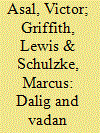

|
|
|
|
|
| Summary/Abstract |
For classes which contain a discussion of strategy, war, political violence, terrorism, insurgency, peace operations, or ethno-nationalist conflict to name a few, students must have an effective, foundational understanding of the complexities of using military force. To that end, we have developed an operational “battlefield” exercise, the Dalig–Vadan Exercise (DVE), which allows an entire class of students to get a sense of the dynamics and complexities of command and execution of competing strategies without any military background, any particular emphasis on time, place, or context, and de-emphasizing the consequences of violence. Anchored on Clausewitz's friction and fog, the DVE provides students with a first-person encounter with decision making in a dynamic, multiparty, informational-limited, and time-sensitive environment that can be related to a wide range of courses and course material in international relations and related fields.
|
|
|
|
|
|
|
|
|
|
|
|
|
|
|
|
| 10 |
ID:
159572
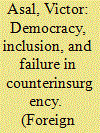

|
|
|
|
|
| Summary/Abstract |
Why do the strong lose? Intuitively, stronger violent actors should win in wars against weaker actors. The literature on insurgencies suggests that democracies will do worse than other countries. However, there is little quantitative literature on why states succeed or fail in their efforts against insurgencies, and the key works find that democracy does not matter. We argue that the combined effect of political inclusion and political competition present in inclusive democracies is a key missing component impacting the success or failure of counterinsurgency (COIN). When procedural elements of democracy are combined with political inclusion, countries are less likely to be successful at suppressing insurgencies because normatively they are less willing to be as repressive and ruthless as necessary. We find that inclusion and procedural democracy separately have no impact on COIN success; however, when combined, the impact is significant, large, and negative. Inclusive democracies lose COIN operations more often than their counterparts.
|
|
|
|
|
|
|
|
|
|
|
|
|
|
|
|
| 11 |
ID:
188055


|
|
|
|
|
| Summary/Abstract |
Many nonstate military organizations provide a wide range of social services to civilians. The apparent contradiction between their use of violence and their provision of charity has been the subject of a great deal of research in the conflict studies literature. Two of the most common sets of arguments hold that such services are either a form of bribery aimed at controlling and isolating constituents and potential recruits, or an extension of the organization’s ideological commitments. Our findings, based on a new analysis of the BAAD dataset, demonstrate that neither explanation is correct. Rather, we find that the provision of social services represents a means of confronting and undermining the authority of the state. In this sense, the provision of social services represents an extension of the broader political goals of the nonstate armed groups providing them.
|
|
|
|
|
|
|
|
|
|
|
|
|
|
|
|
| 12 |
ID:
120768


|
|
|
|
|
| Publication |
2013.
|
| Summary/Abstract |
This article explores those factors that shape a political organization's choice of tactics in political mobilization with a particular focus on the influence of gender ideology on the choice of different type of contentious action. To understand why political organizations engaging in contentious politics choose to employ violent tactics, nonviolent tactics, or a mixture of both, current scholarship has tended to focus on factors such as relationship with the government, external support, and religious or leftist ideology. Far less attention has been given to the role of an organization's ideology relating to gender when predicting its behavior. In addition, much of the analysis of contentious activity has analyzed the use of violence or protest separately and rarely examines the choice of a mixed strategy. We employ a time-series multinomial logistic regression analysis to examine the Middle East Minorities at Risk Organizational Behavior dataset (MAROB), including data over 24 years on 104 ethno-political organizations that have used a range of tactics including protest, violence, and/or a mix of the two, to investigate organizational and state-level variables that lead organizations to choose different strategies. We find that a number of variables can influence a movement's choice to engage in one strategy over another. Gender-inclusive ideology makes an organization more likely to engage in protest and less likely to choose a violent or mixed strategy.
|
|
|
|
|
|
|
|
|
|
|
|
|
|
|
|
| 13 |
ID:
134982


|
|
|
|
|
| Summary/Abstract |
Existing literature on contentious political movements has generally focused on domestic political activity. Using the new Minorities at Risk Organizational Behavior–Middle East data set (MAROB-ME), which contains organization-level data for 104 ethnopolitical organizations in the Middle East and North Africa, we analyze the decision of both violent and nonviolent organizations to engage in political activity transnationally. Among the results, we find that diaspora support is associated with transnational nonviolent protest, whereas foreign state support and domestic repression increase the use of transnational violence. The most robust finding, however, is that participation in the domestic electoral process consistently reduces the likelihood that an organization will engage in any political activity abroad.
|
|
|
|
|
|
|
|
|
|
|
|
|
|
|
|
| 14 |
ID:
154741


|
|
|
|
|
| Summary/Abstract |
What explains the use of military conscription? Using a new data set of more than 100 countries over a period of 200 years, we examine the determinants of a state’s decision to implement a military draft. We argue that the decision to use conscription is largely dependent on historical factors. Specifically, we contend that former British colonies are less likely to use conscription as a means of military recruitment because of an anticonscription precedent set during the English Civil War. We find that former British colonies are far less likely to opt for conscription, even after controlling for counter arguments relating to a state’s colonial legacy. We also examine a number of existing explanations for the use of conscripts, using the data to arbitrate previous debates. We find that democracies are less likely to implement the draft, while states involved in an interstate war or interstate rivalry are more likely to do so.
|
|
|
|
|
|
|
|
|
|
|
|
|
|
|
|
| 15 |
ID:
107646


|
|
|
|
|
| Publication |
2011.
|
| Summary/Abstract |
Why do some terrorist organizations deploy women on the front lines and in violent attacks? This study explores the social conditions, economic factors, and organizational characteristics that might explain women's participation in violent terrorist activity. With a new data set of 395 terrorist organizations, women's participation in terrorist attacks was quantified and coded. The logistic regression analysis results suggest that women's educational attainment, social rights, terrorist organization's age and size, and the level of a country's economic development are important predictors of the deployment of women in terrorist violence while a terrorist group's ideological or religious orientation and the level of democracy do not significantly influence the likelihood of women's participation.
|
|
|
|
|
|
|
|
|
|
|
|
|
|
|
|
| 16 |
ID:
165304
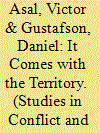

|
|
|
|
|
| Summary/Abstract |
Given that minority ethno-political organizations are generally weaker than states yet seek to change their policies or remove the ruling regime from power, why would negotiation occur? States prefer to ignore or repress such organizations, which typically have little to offer in return amidst negotiations that can legitimize them while delegitimizing the state. When a challenging organization establishes governing structures and controls movement in part of a state's territory, however, it can easily inflict significant economic and political costs on the state while also possessing a valuable asset to exchange for concessions. An organization with territorial control cannot be ignored, while the state will have a strong incentive to negotiate before the state loses more face, the group gains more legitimacy, neighboring states are more likely to invade, and the international community is more likely to formally recognize any facts on the ground as a new status quo. Our analysis of 118 organizations in the Middle East and North Africa from 1980–2004 reveals that territorial control is the most important determinant of intrastate negotiation. In regards to existing scholarship, this suggests that a certain type of successful violence works—not all violence and not only nonviolence—while certain types of strong organizations—those that control territory—are more likely to reach negotiations with the state than weak ones.
|
|
|
|
|
|
|
|
|
|
|
|
|
|
|
|
| 17 |
ID:
138074


|
|
|
|
|
| Summary/Abstract |
This paper presents an analysis of the Provisional Irish Republican Army’s (PIRA) brigade level behavior during the Northern Ireland Conflict (1970-1998) and identifies the organizational factors that impact a brigade’s lethality as measured via terrorist attacks. Key independent variables include levels of technical expertise, cadre age, counter-terrorism policies experienced, brigade size, and IED components and delivery methods. We find that technical expertise within a brigade allows for careful IED usage, which significantly minimizes civilian casualties (a specific strategic goal of PIRA) while increasing the ability to kill more high value targets with IEDs. Lethal counter-terrorism events also significantly affect a brigade’s likelihood of killing both civilians and high-value targets but in different ways. Killing PIRA members significantly decreases IED fatalities but also significantly decreases the possibility of zero civilian IED-related deaths in a given year. Killing innocent Catholics in a Brigade’s county significantly increases total and civilian IED fatalities. Together the results suggest the necessity to analyze dynamic situational variables that impact terrorist group behavior at the sub-unit level.
|
|
|
|
|
|
|
|
|
|
|
|
|
|
|
|
| 18 |
ID:
158845
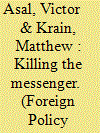

|
|
|
|
|
| Summary/Abstract |
What countries are most dangerous for journalists? Both conventional wisdom and extant literature on political violence, democracy, and reporter fatalities suggest that more democratic systems should make journalists safer. However, we argue that a more democratic context makes it easier for journalists to pursue stories that put them at risk and that they are thus more likely to be killed by actors trying to avoid the spotlight and exposure. Conversely, autocratic regimes provide fewer opportunities to pursue dangerous leads, thereby reducing the chance of being killed. Using novel cross-national data on the number of journalist killings between 1992 and 2008, we find that these arguments are generally supported when controlling for other factors that affect the killing of journalists, such as poor governance and political conflict.
|
|
|
|
|
|
|
|
|
|
|
|
|
|
|
|
| 19 |
ID:
137036
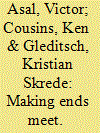

|
|
|
|
|
| Summary/Abstract |
A growing number of datasets collect information reflecting the behavior and characteristics of contentious and violent organizations. Most of these datasets are not arranged so that they can be easily combined for analytical purposes. In particular, there is a lack of common identifiers for organizations. This creates a great deal of duplication of effort as well as many potential stumbling blocks for those who would like to combine information from different datasets for new analyses or research questions. We describe an existing effort to overcome common challenges and link organizations called the Terrorist Organization (TORG) crosswalk. We further propose a new effort, a Shared Contentious Actor Registry (SCAR), to allow for a more comprehensive and concerted effort to meet the challenges in linking data.
|
|
|
|
|
|
|
|
|
|
|
|
|
|
|
|
| 20 |
ID:
188069
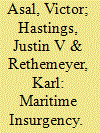

|
|
|
|
|
| Summary/Abstract |
Why do some insurgent organizations launch maritime attacks? To examine why organizations would engage in this behavior we draw on a new dataset of insurgencies to investigate the organizational characteristics associated with maritime attacks. We find that there are two types of maritime attacks by insurgencies. While both types of attacks are associated with the trappings of a state, beyond those factors, maritime revenue-raising attacks take place in a milieu of criminal activity, while maritime non-revenue-raising attacks are associated with an insurgency’s organizational sophistication and capacity.
|
|
|
|
|
|
|
|
|
|
|
|
|
|
|
|
|
|
|
|
|